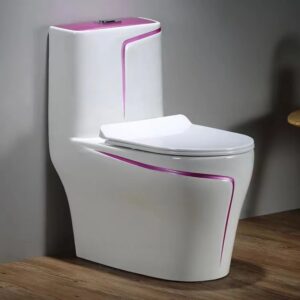
First thing first , let me explain what a is one piece toilet is and what two piece toilet. The main functionality of both toilets is to flush out the waste from the human body.
A water closet consists of three parts: a bowl , a pedestal, and a tank. The toilet’s pedestal is there to provide the necessary height for the toilet. The toilet bowl’s purpose is to collect waste and flush it down the drain pipeline. The tank is to store the water and provide the required pressure to flush out the waste from the toilet.
One piece toilet are those in which the tank and bowl are melded together seamlessly. It also goes by the name “single piece toilet.”
Two piece toilet have separate tanks and toilets that are connected by fittings. It is also called coupled toilets.
Find ten types of toilets here.
Now, let’s dive into the comparison.
When we buy anything, the price will be considered a major point. One piece toilet will be much higher price than the two piece toilet. The Production difficulties of producing a piece are much higher than producing a two piece toilet. So the cost of a piece toilet is double that of a two piece toilet. The winner is A piece of the toilet.


Design availability
Both toilets often come in comparable designs. As you can see in the two toilet versions below, the style is identical, but you have the option of a single piece or a connected closet. Design-wise, both are identical.
Aesthetic look
When you compare between the coupled closet and single piece toilet based on look, then definitely one piece toilet is a clear winner as the product is made with out any joint or gap between tank and body.
Weight
One piece toilet are designed to hold the ceramic tank during the firing cycle in the production cycle, so in the design itself, the products are higher in weight. Normally, the weight of a single piece toilet is around 40 Kgs(88 Pounds). A two piece toilet weight is around 25Kgs (55 Pounds). So, with solid mass, the winner is a piece of the toilet when comparing weight.
Mounting options
As we have seen before the weight of a one piece toilet is higher when compared to a two piece toilet because the weight of one piece can’t be hanged on the wall. So, for coupled closets you can get wall mount and floor mount models, but for one piece only floor models will be available. So if you are looking for a wall hung model then you have to go for two piece toilet.
Size
One piece toilet and two piece toilets have a very little size difference from one another. However, two pieces may be simpler to move since you may buy the toilet and tank separately. Both toilets are around 400 MM (15.7 Inches) in height.
Functionality
The two toilets’ functionality is independent of the toilet model. It is dependent on the toilet’s flushing system and construction. Therefore, the one-piece and two-piece toilets in this comparison are tied on points.
Installation
We may consider installation from two angles:
1. First, installing a one piece toilet is significantly simpler than installing a two piece toilet since the tank and toilet are already attached and no connecting mechanism is required. Two piece toilet fitting is not much easier than one piece toilet because tank and toilet fitting need to be done carefully to avoid water leakage and proper flush functioning.
2. The second one is moving one piece is much more difficult when compared to two pieces because of the very high weight. But moving a two piece toilet is easier because the toilet and tank can be moved separately.
Maintenance
Due to fewer fittings in the one piece toilet the maintenance is very less. An issue in the tank and toilet junction locations is possible with two-piece toilets.
Because there is no joint and no gap in a one-piece toilet, cleaning is comparably simple. But cleaning has to be taken care of in two piece toilet & tank joint areas.
Other Points
1. Glaze colors depend upon the toilet manufacturer. Normally one piece and two piece toilets are available in white and ivory colors. You must seek toilets produced in China if you want toilets that are double-colored and have diverse hues.
2. You may purchase a seat cover for either the soft-close toilet or the hard-close toilet.
3. Both restrooms may be found in “P” and “S” traps.
Conclusion
When comparing the difference between the one piece toilet and the two piece toilet more points favor the one piece toilet. So if you are OK with spending a little more money then definitely go for one piece toilet.
Must Visit:https://ortonbaths.com/understanding-the-mechanism-of-a-rimless-toilet-how-does-it-work/
Must Visit:https://ortonbaths.com/whats-the-mechanism-behind-a-siphonic-toilets-operation/


